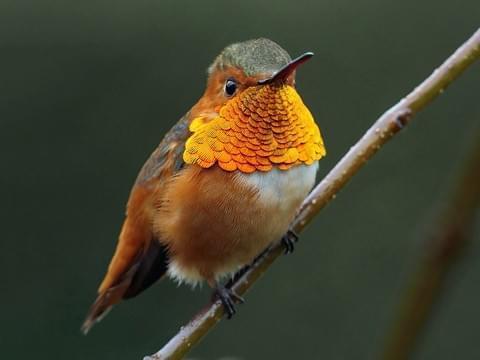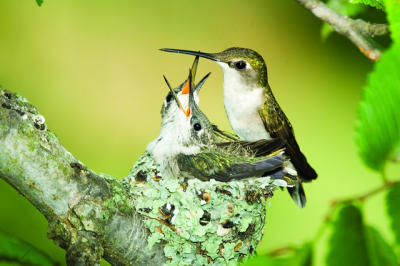Hummingbirds Are Nesting!
It's after the holidays, and everything is slower and calmer as everyone waits for spring. But not for hummingbirds.
In Southern California this is when mother hummingbirds are building nests, laying their tiny eggs and fledging their babies out into the world. It's a time of intense activity as they go about the many tasks of raising baby hummingbirds.

Allen's Hummingbird
Crafting the Nests
Hummingbird nests are tiny cups, about the size of a quarter across. The mothers weave them out of spider silk, moss, lichens and plant fibers, and line them with down from dandelion fluff and kapok pods, or from balls of soft Hummingbird Cotton from Wild Birds Unlimited.
Nests can be many places: high in a tree or in a ficus bush right beside a walkway, if the mother thinks it's safe. They sometimes are braced in the V between two branches. If the location is successful, a mother may use it for several years. So, be careful when pruning, because the little nests are easy to miss.
Raising the Babies
When everything is just right, the mother will lay two eggs the size of small jelly beans. She will sit on them for about 18 days or more if it is cold. She will leave to feed for only about a minute. Even on the nest she has no rest, wiggling and shaking the nest every few seconds. See a live view of a hummingbird mother, Bella, on her nest.
When the babies do hatch, they have no feathers and dark skin. After about a week, they are covered with fluffy feathers, so mother can leave the nest longer. But now she has to find nectar and mix it with bugs (fruit flies are a favorite) in her throat, creating a sort of high-protein formula for the nestlings.

Hummingbird Mother Feeds Babies
At about three weeks, the babies start to look like hummingbirds and begin testing their little wings. They actually will leave the nest for the first time. Mother will feed them for two or three days, but after that, they are on their own in the world.
Though you may miss the babies when they finally are gone, don't worry. If mother liked that nest, she probably will be back again in a month or so to start another family. Just keep your hummingbird feeders full of fresh nectar changed every four or five days.
Hummingbird Rescue
This is a dangerous time for babies and mothers. Babies fall out of nests, and busy mothers sometimes move so fast they hit windows. Luckily, you can help. Put the injured bird in a dark box (to reduce stress) and give no nectar or water. As soon as possible, contact Los Angeles Hummingbird Rescue at 310-804-3715.
Hummers in Southern California
We are lucky to have our hummingbirds year round in Southern California. Most common are the Anna's and Allen's Hummingbirds, but now in winter we can see many more as they traverse the Pacific Flyway, a major migratory route. According to the California Audubon, we can see Rufous Hummingbirds on their way to Canada and Black-Chinned Hummingbirds headed for Northern California. Later in the year, Costa's Hummingbirds will take a break from summer desert heat by visiting the coast.

Male Black-Chinned Hummingbird
Hummingbird Information
All About Birds (Cornell University)
Birds and Blooms (information about nests and attracting hummingbirds to your garden)

